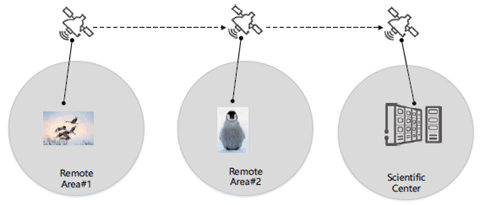Content for TR 22.865 Word version: 19.2.0
5.4 Use case on store and forward - data transfer for IoT devices in remote areas
5.4.1 Description
5.4.2 Pre-conditions
5.4.3 Service Flows
5.4.4 Post-conditions
5.4.5 Existing features partly or fully covering the use case functionality
5.4.6 Potential New Requirements needed to support the use case
...
...
5.4 Use case on store and forward - data transfer for IoT devices in remote areas p. 16
5.4.1 Description p. 16
Data transfer at remote sites is a very common requirement. Research institutions can obtain data from remote sites for scientific research, e.g. animal tracking [5]. Government agencies can obtain data from remote sites for disaster mitigation and avoidance, e.g. via remote sensing [6]. Commercial companies can obtain data from remote sites for proper resource allocation. Data transmission at many remote sites is delay-insensitive, and satellite coverage does not always ensure that satellites connect to both the service link and the feeder link. In the past 30 years, many scholars have devoted themselves to studying the data transmission problem of remote sites, and developed the store and forward mechanisms to solve the problem [7] [8] [9].
In remote areas, there is no terrestrial network for various reasons, e.g. it is difficult to build and maintain communication towers. As a result, this makes it challenging to collect information for environmental protection purposes in these areas. For example, sensors installed on animals need to be monitored regularly. In this scenario, the sensors installed on the animals send the status information, e.g. the movements, physiology and surrounding environment of the animals, to the satellite; and the satellite stores the received status information of the animals, and forwards the information to the scientific centre when a feeder link becomes available.
5.4.2 Pre-conditions p. 16
EA Science Center has installed sensors (IoT devices) on the animals to collect information for environmental protection purposes in these remote areas. Satelles, the satellite communication operator, has launched the Store & Forward Satellite operation to support the data transferring for the remote areas. EA Science Center has signed contract with Satelles to allow sensors installed on animals to send the status information (e.g. the movements, physiology and surrounding environment of the animals) to the Science Center via satellite.
The satellite and the IoT devices are properly configured with sufficient information, e.g. credential/certificate that is needed for the devices to verify the authenticity of the satellite.
5.4.3 Service Flows p. 16

- The IoT devices are installed on animals and powered on, they are registered with the 5G network for the Store & Forward Satellite operation. The satellite with the store and forward function enables the IoT devices to transfer data to the network, even when the feeder link to the ground is not available. A secured connection between an IoT device and the satellite is established to protect the data security and privacy.
- The IoT devices send sensor status information to the satellite, the satellite stores the sensor status information received from the IoT devices.
- When the satellite has the feeder link available to the ground segment, the satellite forwards the sensor status information, as well as other necessary information, to the ground core network. The ground core network verifies the IoT devices based on the information received; if it is allowed, the ground core network forwards the sensor status information to its destination data network.
- The ground core network sends the result of the operation to the satellite (the same satellite or a different one that will pass through the remote area).
- When the satellite (or next satellite) passes through the remote area, the satellite pages the UE, and based on the result received from ground core network, the satellite sends result of the operation to the IoT devices.
- If an IoT device needs to update the sensor status information, it can send it to the satellite when it is connected to the satellite. The satellite stores it and forwards the sensor status information to the ground core network when feeder link becomes available.
5.4.4 Post-conditions p. 17
After the scientific centre receives the sensor status information, the scientists can analyse the sensor status information, and track the status of the animals.
5.4.5 Existing features partly or fully covering the use case functionality p. 17
None.
5.4.6 Potential New Requirements needed to support the use case p. 17
[PR 5.4.6-001]
The 5G system with satellite access shall support mechanisms to store user data, received from UEs via satellite access, on the satellite and forward it when feeder link between the satellite and the ground segment is available.
[PR 5.4.6-002]
The 5G system with satellite access shall support mechanisms for a user to securely register a UE to use the Store & Forward Satellite operation when satellite connectivity is intermittently/temporarily unavailable.
[PR 5.4.6-003]
The 5G system with satellite access shall support mechanisms to authenticate and authorize a UE for the Store & Forward Satellite operation.
[PR 5.4.6-004]
The 5G system with satellite access shall be able to limit the total amount of the stored data received from a UE when using the Store & Forward Satellite operation.
[PR 5.4.6-005]
The 5G system with satellite access shall be able to collect charging information per UE for use of the Store & Forward Satellite operation (e.g., data volume, duration, involved satellites).
[PR 5.4.6-006]
The 5G system with satellite access shall be able to collect charging information per application for use of the Store & Forward Satellite operation (e.g., number of UEs, data volume, duration, involved satellites).